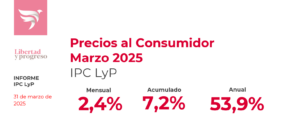
Aldo Abram
Opiniones de Aldo Abram fueron mencionadas en un artículo del Wall Street Journal.
“Si la política establecida por el Sr. Sandleris y su equipo continúa, podría dar paso a una nueva era de estabilidad monetaria argentina. Eso no es poca cosa en un país donde 13 ceros se han desprendido del peso desde 1970. Según Aldo Abram, un economista y director argentino de la Fundación Libertad y Progreso en Buenos Aires, un billete de un peso en 1970 es hoy igual. A 10 billones de pesos.”
Argentina’s Monetary Rescue
An end to money creation brings down inflation and stabilizes the peso.
Por Mary Anastasia O’Grady
Guido Sandleris isn’t a politician, but he could be the most influential figure in Argentina’s politics over the next 10 months.
Since September the 47-year-old economist, who studied at the University of Buenos Aires, Columbia University and the London School of Economics, has been governor of Argentina’s central bank. His tenure coincides with dramatic changes in the bank’s monetary policy, halting a peso plunge that took 55% off the value of the currency between mid-December 2017 to the end of September.
If the policy set by Mr. Sandleris and his team continues, it could usher in a new era of Argentine currency stability. That’s no small thing in a country where 13 zeros have been lopped off the peso note since 1970. According to Aldo Abram, an Argentine economist and director at the Liberty and Progress Foundation in Buenos Aires, a one-peso note in 1970 is today equal to 10 trillion pesos.
Handicapping a winner for the October 2019 presidential election is already the hottest parlor game in Buenos Aires. President Mauricio Macri ought to be the odds-on favorite. But a series of fiscal-policy missteps since he took office in 2015 have disappointed the nation. Early polling now suggests the possibility that Peronist former President Cristina Kirchner could return to power.
As president, Mrs. Kirchner destroyed the economy and undermined institutions. She faces multiple corruption indictments. Yet the Peronist machine is powerful. Unless Mr. Macri can turn things around, many Argentines will look for an alternative when they go to the polls.
Mr. Macri started out on the right foot in 2015. He lifted capital controls and freed the exchange rate. The peso immediately weakened and inflation shot up, but it was a necessary adjustment.
The trouble is that Mr. Macri resisted downsizing the public sector and even expanded the cabinet and its bureaucracy. The central bank viewed the persistence of large fiscal deficits as a threat to the availability of credit for the private sector and growth. So it kept issuing pesos. This fueled inflationary expectations and demolished central-bank credibility.
Demand to hold pesos plummeted. By September Argentina was again in the throes of a currency crisis. Disbursements under an International Monetary Fund rescue program had to be accelerated. The central bank appeared to be such a lost cause that I recommended dollarization.
Enter Mr. Sandleris, whose initial challenge—as it is with any inflationary spiral—was to create a shock to expectations. He did this by freezing the monetary base—putting an end to the issuance of new money.
The central bank also introduced a new foreign-exchange intervention rule: As long as the peso trades within a band (plus or minus 15% of an established price) the central bank won’t intervene in the foreign-exchange market. If the peso weakens beyond the band, the central bank has the authority but not the obligation to use up to $150 million a day of international reserves to buy pesos. It can also intervene at the other end of the band to sell pesos, but only up to the equivalent of $50 million a day.
The rule isn’t intended to provide a floor price but to signal to the market that there is liquidity. Importantly, the intervention won’t be “sterilized,” which is to say that the central bank won’t put the pesos it removes from the market back into circulation by buying debt. Instead, those pesos will be extinguished.
My sources tell me this is the first time there has been a commitment to fully “unsterilized” intervention under an IMF program. That sounds about right, since the fund has a record of preferring devaluation to sound money. Putting an end to money creation and destroying excess pesos will shrink the quantity of money in circulation, stabilize the price of the peso, and bring down inflation.
The plan has the full support of the U.S. Treasury, and for good reason. Since it was launched, the peso is up about 12% against the dollar. Monthly core inflation was 3.3% in November, down from 7.6% in September and 4.5% in October. If the central bank sticks with the program, 2% monthly core inflation will be achievable by the beginning of 2019, with more disinflation expected throughout the year. Peso interest rates have also come down, which is a prerequisite for a return to growth.
Many risks remain, and, as Mr. Abram pointed out to me last week, it is particularly worrying that the government aims to bring down the fiscal deficit using a heavy tax burden rather than making sufficient cuts in lavish public spending. Country risk—which measures concerns about default—is still high.
Yet he also stressed the importance of this crucial first step in monetary policy. “We need a central bank that recovers confidence. Without monetary stability, it’s impossible to do anything.” Truer words were never spoken.
Write to O’[email protected].





























